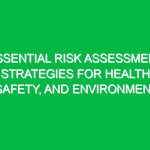Introduction
Risk assessment is a critical process in the Health, Safety, and Environment (HSE) domain. It refers to the systematic identification, evaluation, and prioritization of risks associated with hazards in the workplace and environment. This process not only helps organizations comply with legal requirements but also enhances workplace safety, protects the environment, and promotes a culture of health and safety among employees. In a world where safety and environmental concerns are constantly evolving, understanding and effectively executing risk assessment is more crucial than ever.
This guide will delve into the nuances of risk assessment, its significance in the HSE sector, key components, methodologies, and the regulations that govern it. We will explore real-life examples and best practices to equip you with a comprehensive understanding of how to implement risk assessment effectively in your organization.
Understanding Risk Assessment in the HSE Context
Risk assessment, in the context of health, safety, and environment, involves several core components:
1. Identification of Hazards
The first step in risk assessment is the identification of potential hazards. Hazards can take many forms, including physical (e.g., machinery), chemical (e.g., toxic substances), biological (e.g., bacteria), ergonomic (e.g., repetitive movements), and psychosocial (e.g., workplace stress). A thorough hazard identification process involves reviewing workplace activities, consulting with employees, and analyzing accident reports to pinpoint potential risks.
For example, consider a construction site. The hazards may include heavy machinery, heights, electrical installations, and toxic materials. Identifying these hazards requires a keen eye for detail and a comprehensive understanding of the work environment.
2. Risk Evaluation
Once hazards are identified, the next step is to evaluate the risks associated with them. This involves assessing the likelihood of an incident occurring and the potential consequences. Risk evaluation typically employs a risk matrix, which categorizes risks as low, medium, or high based on their severity and likelihood.
For instance, a risk assessment of a chemical spill might reveal that while the likelihood of such an event is low, the consequences could be catastrophic. In such cases, organizations must implement stringent controls to mitigate these risks.
3. Risk Control Measures
After evaluating risks, it is essential to establish appropriate control measures to mitigate them. These measures can be categorized into the following:
- Elimination: Removing the hazard altogether (e.g., substituting a toxic chemical with a non-toxic alternative).
- Substitution: Replacing a hazardous substance or process with a safer one.
- Engineering Controls: Implementing physical changes to the workplace (e.g., installing ventilation systems).
- Administrative Controls: Modifying work practices (e.g., rotating job tasks to minimize exposure).
- PPE (Personal Protective Equipment): Providing safety gear to employees (e.g., gloves, helmets).
An effective risk control strategy often employs a combination of these measures. For example, in a laboratory setting, one might eliminate certain chemicals, provide proper ventilation, and require lab coats and goggles for protection.
4. Monitoring and Review
Risk assessment is not a one-time event; it requires ongoing monitoring and review. As workplace conditions change, new hazards may emerge, or existing risks may evolve. Regularly reviewing risk assessments ensures that control measures remain effective and relevant.
For instance, consider a factory that introduces new machinery. A risk assessment should be conducted to identify any new hazards associated with the machinery and adapt control measures accordingly.
Benefits of Effective Risk Assessment
Implementing a robust risk assessment process offers numerous benefits, including:
- Enhanced Safety: By identifying and controlling risks, organizations can reduce the likelihood of accidents and injuries.
- Regulatory Compliance: Effective risk assessments help organizations meet legal requirements, reducing the likelihood of fines and penalties.
- Improved Employee Morale: A commitment to safety fosters a culture of trust and care among employees, enhancing their overall morale and productivity.
- Financial Savings: Reducing accidents and injuries leads to lower insurance costs and fewer disruptions to operations.
- Environmental Protection: Risk assessments contribute to environmental sustainability by identifying and mitigating potential harm to ecosystems.
Best Practices for Conducting Risk Assessments
To ensure the effectiveness of risk assessments, organizations should consider the following best practices:
1. Involve Employees
Engaging employees in the risk assessment process is crucial. They often have firsthand knowledge of potential hazards and can provide valuable insights. Conducting workshops or brainstorming sessions can foster a collaborative approach to identifying risks.
2. Use a Structured Approach
Adopt a structured methodology for risk assessment. This could involve using established frameworks such as ISO 31000 or the Risk Management Standard. A structured approach ensures consistency and thoroughness in the process.
3. Document Everything
Maintain comprehensive records of all risk assessments, including hazard identification, risk evaluations, control measures, and reviews. Documentation not only aids in compliance but also serves as a reference for future assessments.
4. Train Employees
Provide training on risk assessment procedures and the importance of safety. Empowering employees with knowledge about risks and controls can significantly enhance an organization’s safety culture.
5. Review Regularly
Set a schedule for regular reviews of risk assessments. This could be annually or whenever significant changes occur in the workplace. Regular reviews ensure that the risk assessment remains relevant and effective.
Regulations and Standards Impacting Risk Assessment
The landscape of health, safety, and environmental regulations is vast and often complex. Various regulations govern risk assessment practices, including:
1. Occupational Safety and Health Administration (OSHA)
In the United States, OSHA sets forth requirements for employers to conduct risk assessments as part of their obligation to provide a safe workplace. Compliance with OSHA standards not only protects employees but also shields organizations from potential legal repercussions.
2. Health and Safety at Work Act 1974 (HSWA)
In the UK, the HSWA mandates employers to ensure, as far as is reasonably practicable, the health and safety of employees. This includes conducting risk assessments to identify and mitigate workplace hazards.
3. Environmental Protection Agency (EPA)
The EPA regulates environmental risks associated with various activities. Organizations must conduct environmental risk assessments to comply with EPA regulations, ensuring that their operations do not harm ecosystems and public health.
Conclusion
Risk assessment is an essential component of health, safety, and environmental management. By systematically identifying, evaluating, and controlling risks, organizations can create safer workplaces, comply with regulations, and contribute to environmental sustainability.
Incorporating best practices, employee involvement, and regular reviews into the risk assessment process can further enhance its effectiveness. As we navigate a world filled with evolving risks and challenges, prioritizing risk assessment is not just a compliance necessity; it is a commitment to the well-being of employees and the environment alike.
Encouraging a culture of safety and proactive risk management is a step towards a healthier, safer, and more sustainable future. By taking action today, organizations can pave the way for tomorrow’s success in health, safety, and environmental stewardship.


